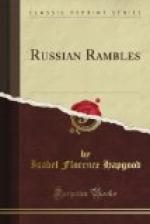He smiled, and, dropping his brush, made the sign of the cross over us. I was perfectly willing to kiss his pretty, plump hand,—I had become very skillful at that sort of thing,—but I confess that I shrank from the obligatory salute to the skull, and from that special chrism. Nevertheless, I wished the Russians to think that I had gone through with the whole ceremony, if they should chance to look back. I felt sure that I could trust the priest to be liberal, but I was not so certain that our lay companions, who were petty traders and peasants, might not be sufficiently fanatical to construe our refusal into disrespect for their church, and resent it in some way.
Though we returned to the monastery more than once after that, we were never attracted to the catacombs again, not even to witness the mass at seven o’clock in the morning in that subterranean church. The beautiful services in the cathedral, the stately monks, the picturesque pilgrims, with their gentle manners, ingenuous questions, and simple tales of their journeys and beliefs, furnished us with abundant interest in the cheerful sunlight aboveground.
Next to the Catacombs Monastery, the other most famous and interesting sight of Kieff is the Cathedral of St. Sophia. Built on the highest point of the ancient city, with nine apses turned to the east, crowned by one large dome and fourteen smaller domes,—all gilded, some terminating in crosses, some in sunbursts,—surrounded by turf and trees within a white wall, with entrance under a lofty belfry, it produces an imposing but reposeful effect. The ancient walls, dating from the year 1020, are of red brick intermixed with stone, stuccoed and washed with white. It has undergone changes, external and internal, since that day, and its domes and spires are of the usual degenerate South Russian type, without a doubt of comparatively recent construction. So many of its windows have been blocked up by additions, and so cut up is its space by large frescoed pillars, into sixteen sections, that one steps from brilliant sunshine into deep twilight when he enters the cathedral. It is a sort of church which possesses in a high degree that indefinable charm of sacred atmosphere that tempts one to linger on and on indefinitely within its precincts. Not that it is so magnificent; many churches in the two capitals and elsewhere in Russia are far richer. It is simply one of those indescribable buildings which console one for disappointments in historical places, as a rule, by making one believe, through sensations unconsciously influenced, not through any effort of the reason, that ancient deeds and memories do, in truth, linger about their birthplace.
Ancient frescoes, discovered about forty years ago, some remaining in their original state, others touched up with more or less skill and knowledge, mingle harmoniously with those of more recent date. Very singular are the best preserved, representing hunting parties and banquets of the Grand Princes, and scenes from the earthly life of Christ. But they are on the staircase leading to the old-fashioned gallery, and do not disturb the devotional character of the decoration in the church itself.




